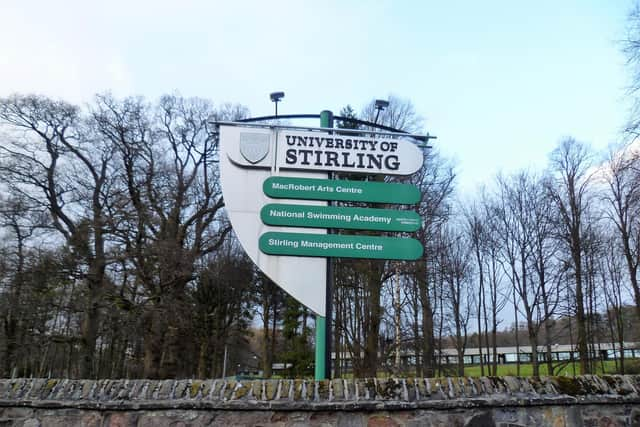Exclusive:Scottish university boss handed 'shocking' pay rise of £76,000 while staff and students struggled
The boss of a Scottish university was handed a £76,000 pay rise last year while the cost-of-living crisis caused misery for thousands of staff and students, it can be revealed.
Stirling University’s principal Sir Gerry McCormac saw his salary soar by £68,000 to £363,000 between 2022 and 2023, while his total package increased by £76,000 to £396,000 – a rise of more than 23 per cent.
Advertisement
Hide AdAdvertisement
Hide AdIt follows an increase of £23,000 between 2021 and 2022, meaning his overall remuneration has rocketed by just under £100,000 in two years – an uplift of almost 33 per cent.


The “shocking” rise, which came as staff were engaged in industrial action over pay, was branded a “slap in the face” by a trade union leader last night.
Stirling University said the principal’s pay was “appropriate to the size and scale of the job”, and that Sir Gerry had previously declined pay increases recommended by the university’s remuneration committee over several years.
Last year, The Scotsman revealed how university principals in Scotland had shared pay rises worth a combined £300,000 in 2022, after many had agreed to take cuts during the Covid-19 pandemic.
Now further increases have been revealed by several institutions, at a time when many have been complaining about the impact of Government funding cuts.
Sir Gerry, who has been in post since 2010, is now thought to earn more than every other higher education principal in Scotland, except Edinburgh University’s Sir Peter Mathieson and Glasgow University’s Sir Anton Muscatelli, although Strathclyde University is among those still to publish its accounts for last year.
The total package received by the Stirling University boss, including pension contributions, now exceeds that of Dame Sally Mapstone at St Andrews University, despite her overall remuneration increasing by £29,000 to £378,000 last year.
This rise was as a result of a salary review at St Andrews in 2021, rather than a pay increase last year. She had previously donated the additional salary she received in 2021/22, after tax, to the St Andrews Student Hardship Fund.
Advertisement
Hide AdAdvertisement
Hide AdAt Dundee University, principal Iain Gillespie’s total package increased by £13,000 to £316,000, while Sir Peter’s at Edinburgh University went up by £12,000 to £418,000. There was also a £12,000 rise for Robert Gordon University boss Steve Olivier, to just more than £272,000.
Glasgow University confirmed the total package for its principal, including contributions in lieu of pension, was up by £17,000 to £399,000 last year.
Meanwhile, there was a £9,000 uplift last year for the principal of Napier University, an £8,000 rise at the Royal Conservatoire of Scotland, an increase of £7,000 at Queen Margaret University, and of £3,000 at Scotland's Rural College.
Staff at Stirling University took strike action last year over the “hard-line stance” of bosses after they planned to dock the pay of academics who took part in the University and College Union’s (UCU) marking and assessment boycott.
Last year, Stirling University union president Leen Ali also told The Scotsman the cost-of-living crisis and accommodation shortages meant students were “worse off now than they’ve ever been before”.
Jo Grady, general secretary of the UCU trade union, said: “It’s shocking to see some university principals once again maximising their income while holding staff pay down.
"The 23 per cent pay hike of one principal is a slap in the face for all of those workers – UCU members – who participated in unprecedented levels of industrial action over the past year to try to secure an inflation proofed pay rise and decent working conditions.
"At a time when the sector is facing cuts to its budgets and university staff were left with a real-terms pay cut, principals should be looking to offer real leadership by working for the future of higher education rather than trying to take what they can, while they can.”
Advertisement
Hide AdAdvertisement
Hide AdA University of Stirling spokesperson said: “The principal’s salary is set by the university’s remuneration committee, at a level that is appropriate to the size and scale of the job. As stated in the financial statements 2022/23, £363,000 reflects the total pay package in that year.
“For the previous eight years, beyond the national pay award, the principal declined any increase determined by the remuneration committee.”
Stirling University has previously said the near 8 per cent rise between 2021 and 2022 was linked to a nationally agreed pay increase of 1.5 per cent, which was awarded to all staff in 2021, as well as changes associated with tax rules and employer pension contribution rate.
Several other universities are still to be publish financial statements for last year, including Aberdeen, Strathclyde, Heriot-Watt, Glasgow Caledonian and the West of Scotland.
A spokesperson for Universities Scotland, which represents higher education institutions, said it remained “an incomplete set of data”, which could give a “skewed picture” of the overall situation across the sector.
"Headline figures will include the range of elements of a remuneration package, all of which are published in institutions’ financial statements,” the spokesperson said.
"We cannot comment on individual packages, but when it comes to the governance of remuneration decisions it is important to stress that principals are not responsible for setting their salaries; that is decided by remunerations committees.
"Remuneration committees are established by and report to universities’ governing bodies, which include extensive student and staff membership. They are expected to make evidence-based decisions in the public interest and to seek the views of students and staff, including through representatives sitting on the committee itself.”
Comments
Want to join the conversation? Please or to comment on this article.
